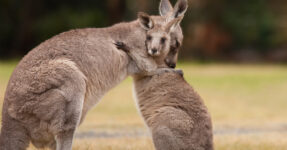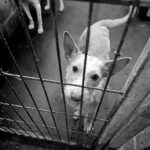The Law, Defences and Penalties for Aggravated Animal Cruelty in New South Wales

Two teenagers have been charged over the alleged beating and killing of 14 kangaroos on the NSW South Coast, and will face court in November 2021.
Police appealed to the community for help after the dead bodies of the kangarros were found at Long Beach, near Batemans Bay. Investigations eventually led to the arrest of the two teens.
The sole surviving joey was taken into care by WIRES volunteers and is now on the mend. She has been named ‘Hope.’
The pair will face the Children’s Court, as they are under the age of 18 years and are considered to be ‘young persons’ under the law.
Young people and crime
According to data from the Australian Bureau of Statistics, there were 17,710 offenders under the age of 18 years in New South Wales in the year 2019-2020.
The statistics suggest that young persons made up 15% of the total number of offenders across the state during that period of time, and the most common offences were fare evasion and acts intended to cause injury.
In most states and territories in Australia, persons as young as 10 years old can be held responsible for a criminal offence.
The ACT is the only jurisdiction that has raised the age of criminal responsibility to 14 years of age.
The Children’s Court
There are many varied and often complex reasons why young people commit crimes, and the Children’s Court which was founded in the early 1900s and while it has the jurisdiction to impose a punishment that it believes is appropriate to the crime.
The Children’s Court runs a little less formally than other courts and puts a strong focus on prevention, intervention and rehabilitation for young offenders, taking a view that young people who commit crimes often have a good chance at turning their lives around.
It has also long been acknowledged that locking children up in juvenile detention does more harm than good, and it can be the actual catalyst that sets them up for a lifetime of crime.
Typically, the young offenders who do end up in custody are likely to have committed very serious offences.
The offence of animal cruelty in NSW
Section 5 of the Prevention of Cruelty to Animals Act 1979 (NSW) (‘the Act’) makes it an offence to commit ‘an act of cruelty’ upon an animal.
Section 4 of the Act defines an ‘animal’ as:
(a) a member of a vertebrate species including any:
(i) amphibian, or
(ii) bird, or
(iii) fish, or
(iv) mammal (other than a human being), or
(v) reptile, or
(b) a crustacean but only when at a building or place (such as a restaurant) where food is prepared or offered for consumption by retail sale in the building or place.
The same section defines ‘cruelty’ as including any beating, kicking, wounding of an animal, exposure to excessive heat or cold or inflicting pain on an animal.
Cruelty also includes failing to take reasonable care of an animal, or to take reasonable steps to alleviate pain or suffering, or to provide necessary veterinary treatment.
It is also an offence to authorise another person to commit an act of cruelty on an animal that you own, or are in charge of.
The maximum penalty for animal cruelty is 6 months imprisonment and/or a fine of $5,500 for an individual, or a $27,500 fine for a corporation.
The offence of aggravated animal cruelty in NSW
Section 6 of the Act relates to ‘aggravated cruelty’, which is defined by section 4 as:
(a) causing the death, deformity or serious disablement of the animal, or
(b) where the animal is so severely injured, so diseased or in such a physical condition that it is cruel to keep it alive.
The offence is made out where such an act is deliberately or recklessly caused.
A person is ‘reckless’ if he or she foresaw the possibility of any of the above occurred, but went ahead with the actions regardless.
The maximum penalty for aggravated animal cruelty is 2 years imprisonment and/or a fine of up to $22,000 for individuals, or a fine of $110,000 for corporations.
Defences to animal cruelty charges
A whole range of defences to animal cruelty are contained in section 24 of the Act, including religious slaughter; see section 24(c)(i) below.
The section says that a person is not guilty of animal cruelty where the act was committed against:
(a) (i) a stock animal–in the course of, and for the purpose of, ear-marking or ear-tagging the animal or branding, other than firing or hot iron branding of the face of, the animal,
(ii) a pig of less than 2 months of age or a stock animal of less than 6 months of age which belongs to a class of animals comprising cattle, sheep or goats–in the course of, and for the purpose of, castrating the animal,
(iii) a goat of less than 1 month of age or a stock animal of less than 12 months of age which belongs to the class of animal comprising cattle–in the course of, and for the purpose of, dehorning the animal,
(iv) a sheep of less than 6 months of age–in the course of, and for the purpose of, tailing the animal, or
(v) a sheep of less than 12 months of age–in the course of, and for the purpose of, performing the Mules operation upon the animal, in a manner that inflicted no unnecessary pain upon the animal,
(b) where the act of cruelty is done in the course of, and for the purpose of:
(i) hunting, shooting, snaring, trapping, catching or capturing the animal, or
(ii) destroying the animal, or preparing the animal for destruction, for the purpose of producing food for human consumption, in a manner that inflicted no unnecessary pain upon the animal,
(c) in the course of, and for the purpose of, destroying the animal, or preparing the animal for destruction:
(i) in accordance with the precepts of the Jewish religion or of any other religion prescribed for the purposes of this subparagraph, or
(ii) in compliance with any duty imposed upon that person by or under this or any other Act,
(e) in the course of, and for the purpose of:
(i) carrying out animal research, or
(ii) supplying animals for use in connection with animal research,
in accordance with the provisions of the Animal Research Act 1985, or
(f) for the purpose of feeding a predatory animal lawfully kept by the person if:
(i) the act concerned was the release of live prey for the predatory animal, and
(ii) the diet of the predatory animal included animals of the kind released, and
(iii) the person believed on reasonable grounds that the feeding of live prey to the predatory animal was necessary for the predatory animal’s survival because the predatory animal would not eat a dead animal or meat from a dead animal.
Other defences to the criminal charge include duress and necessity.
The offence of serious animal cruelty in NSW
Section 530 of the Crimes Act 1900 (NSW) makes it an offence punishable by a maximum penalty of 5 years in prison to commit an act of ‘serious animal cruelty’, which is where a person, with the intention of inflicting severe pain:
(a) tortures, beats or commits any other serious act of cruelty on animal, and
(b) kills or seriously injures or causes prolonged suffering to the animal.
For the purposes of the offence,
- An “animal” is defined as a mammal (other than a human being), a bird or a reptile, and
- To “kill or seriously injure” an animal includes using the animal as a lure or kill, and
- A “serious act of cruelty” includes using the animal as a lure or kill.
The section imposes a 3 year maximum penalty where the act was committed recklessly rather than intentionally.
A person is not criminally responsible for the offence if the conduct occurred:
- In accordance with an authority conferred by or under the Animal Research Act 1985 or any other Act or law, or
In the course of or for the purposes of routine agricultural or animal husbandry activities, recognised religious practices, the extermination of pest animals or veterinary practice.
Again, duress and necessity are defences to this charge.








